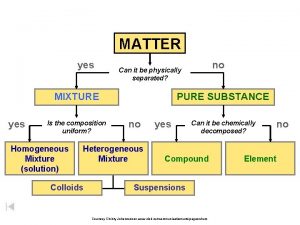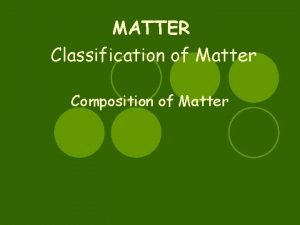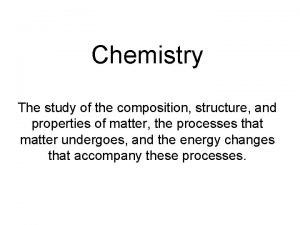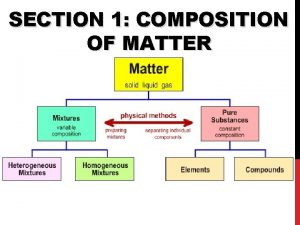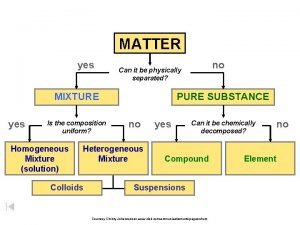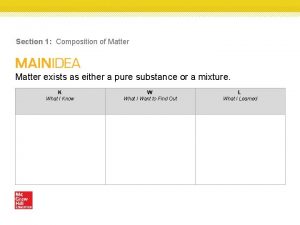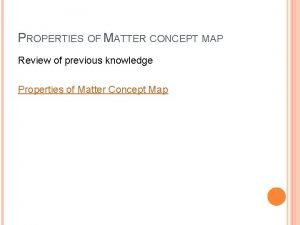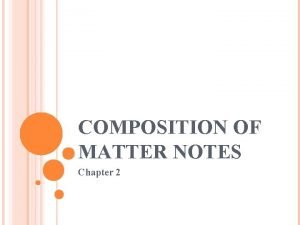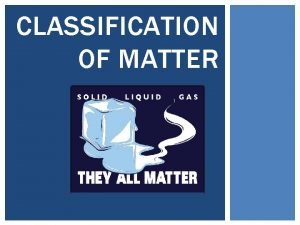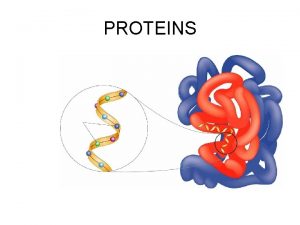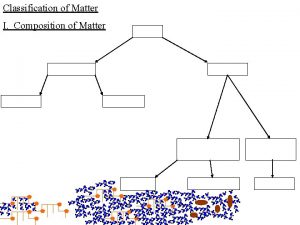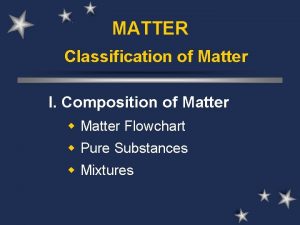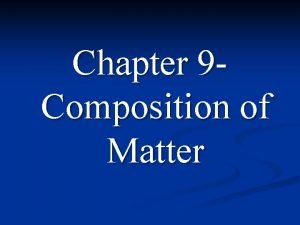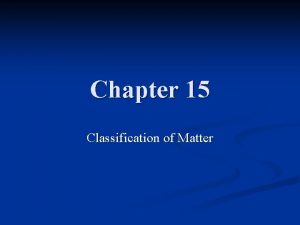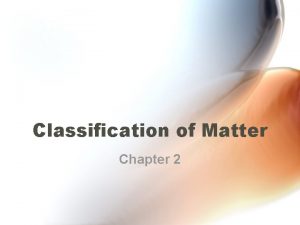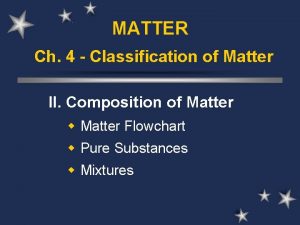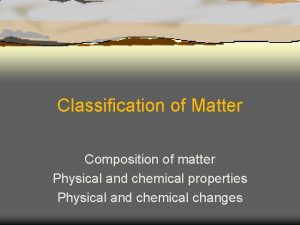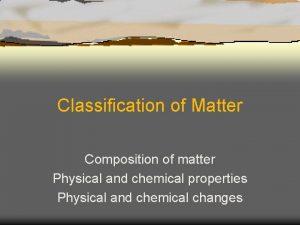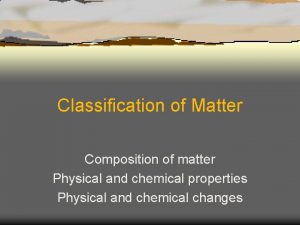CLASSIFICATION OF MATTER COMPOSITION OF MATTER Chapter 15




















- Slides: 20

CLASSIFICATION OF MATTER

COMPOSITION OF MATTER Chapter 15. 1

MATTER Matter: anything that has mass and takes up space

PURE SUBSTANCES A substance is a type of matter with a fixed composition § Can either be a an element or a compound § Ex. Helium, aluminum, water, salt

PURE SUBSTANCES All substances are built from atoms. If all the atoms in a substance have the same identity, then that substance is an element § Example: copper, mercury, and all the other elements on the periodic table

PURE SUBSTANCES Compound is a substance in which the atoms of two or more elements are combined in a fixed proportion § Example: water, salt, sugar, baking soda Salt Sugar

MIXTURES A mixture is a material made up of two or more substances that can be easily separated by physical means

MIXTURES Heterogeneous mixture: the different components of the mixture can easily be distinguished § Ex: granite, concrete, dry soup mixes

MIXTURES Homogeneous mixture: have a consistent composition and properties throughout. Consists of only one phase. Solution: A homogeneous mixture of particles so small that they cannot be seen with a microscope and will never settle to the bottom of their container.

COLLOIDS Colloid: a type of mixture with particles that are larger than those in solutions but not heavy enough to settle out § Ex: paint, milk, fog, smoke

SUSPENSIONS Suspension: a heterogeneous mixture containing a liquid in which visible particles settle § Ex: pond water

Identify the following substances as either: element, compound, homogeneous mixture, heterogeneous mixture, colloid or suspension Sugar Compound Sweet tea Homogeneous mixture powerade Homogeneous mixture Carbon Element smoke Colloid A fresh glass of coca-cola Heterogeneous mixture

MATTER: PROPERTIES, CLASSIFICATION AND CHANGES Chapter 15. 2

PROPERTIES OF MATTER Physical Property - a quality or condition of matter that can be observed without changing the arrangement of atoms that make it Examples: § color § size § shape § state of matter § Texture What are the physical properties of this penguin? These properties can usually be observed using our senses or are something measurable.

Chemical Properties – property that can only be observed when the arrangement of particles that make the matter are altered These properties usually tell you how a substance will react in the presence of a second substance. Examples: Iron reacts with oxygen to form rust. Metals react with acids to form hydrogen gas.

Identify the following as either a physical property or a chemical property. Property Physical a shirt is red √ sodium is so soft it can be cut with a knife √ Chemical potassium reacts vigorously with water √ paper is flammable √ water boils at 100 o. C √

CHANGES IN MATTER Physical Changes – changes in matter that does not alter the arrangement of atoms that make the matter Changes in size, shape, and STATE OF MATTER. Examples: crumpling up a piece of paper breaking a stick in half melting ice salt dissolving in water

Chemical Changes - changes in matter that DO alter the arrangement of atoms that make up the matter Because you can’t see the particles to determine if arrangement has changes, you can look for clues that tell you a chemical change has occurred. Clues of a Chemical Change: 1. permanent color change 2. production of a solid (precipitate is formed) 3. production of a gas 4. change in energy (heat, light or sound) 5. odor change

Identify the following as either a physical change or a chemical change. Change Physical burning toast Chemical √ breaking a glass √ melting butter √ leaves changing color √ fireworks exploding √

LAW OF CONSERVATION OF MASS Matter is neither created nor destroyed during a chemical change The mass of all substances that are present before a chemical change equals the mass of all the substances that remain after the change
 Section 1 composition of matter
Section 1 composition of matter Classification of matter section 1 composition of matter
Classification of matter section 1 composition of matter Classification of matter section 1 composition of matter
Classification of matter section 1 composition of matter What is composition in matter
What is composition in matter Chapter 2 matter section 1 classifying matter answer key
Chapter 2 matter section 1 classifying matter answer key Uniform in composition
Uniform in composition Composition of matter which depends on temperature.
Composition of matter which depends on temperature. The study of composition structure and properties of matter
The study of composition structure and properties of matter Composition of matter section 1
Composition of matter section 1 Variable composition
Variable composition Classification of matter flowchart
Classification of matter flowchart Section 1 composition of matter
Section 1 composition of matter Concept map about matter
Concept map about matter Composition of matter flow chart
Composition of matter flow chart Number of proton
Number of proton Liquid information
Liquid information Mixture
Mixture Protein elements
Protein elements White matter
White matter What makes up the diencephalon
What makes up the diencephalon Gray matter and white matter
Gray matter and white matter





